A Quantitative Groundwater Resource Management under Uncertainty Using a Retrospective Optimization Framework
Abstract
:1. Introduction
2. Materials and Methods
2.1. ROA for Groundwater Resource Management
2.1.1. Optimization Problem
2.1.2. ROA Framework
- (1)
- For a given available data (in this case hydraulic conductivity field mean, standard deviation) generate set of realizations of aquifer hydraulic conductivity fields .
- (2)
- For each given realization run the MODFLOW simulation model to generate responses (i.e., random responses of hydraulic heads/water table level drawdowns) due to a unit groundwater pumping rate (we consider existing maximum groundwater pumping rate to represent a unit pumping rate).
- (3)
- Generate a sequence of a finite set of independent identically distributed samples of random aquifer response matrices of realizations of , for.
- (4)
- For a given sequence of a finite set of the generated samples of aquifer response matrices realized generate a sequence of retrospective sample path sub-problems .
- (5)
- For each kth sample path sub-problem apply core optimizer solver to provide an optimal solution (or a nearly closer approximation of optimal solution) of .
2.1.3. Sampling Technique
2.2. Application of ROA Framework
● Objective
● Constraints
● Statement of the Management Problem
2.3. Description of Formulation of the Sample Path Optimization Sub-Problems
3. Discussion of Results
4. Conclusions and Recommendations
Acknowledgments
Author Contributions
Conflicts of Interest
References
- Tian, J.; Li, C.; Liu, J.; Yu, F.; Cheng, S.; Zhao, N.; Jaafar, W.Z.W. Groundwater Depth Prediction Using Data-Driven Models with the Assistance of Gamma Test. Sustainability 2016, 8, 1076. [Google Scholar] [CrossRef]
- Lee, Y.; Tung, C.; Lee, P.; Lin, S. Personal Water Footprint in Taiwan: A Case Study of Yunlin County. Sustainability 2016, 8, 1112. [Google Scholar] [CrossRef]
- Ndambuki, J.M. Multi-Objective Groundwater Quantity Management: A Stochastic Approach; DUP Science, Delft University Press: Delft, The Netherlands, 2001. [Google Scholar]
- Gelhar, L.W. Stochastic Subsurface hydrology: From Theory to Application. Water Resour. Res. 1986, 22, 135S–145S. [Google Scholar] [CrossRef]
- Safavi, H.R.; Bahreini, G.R. Conjunctive Simulation of Surface Water and Groundwater Resources under Uncertainty. Iran. J. Sci. Technol. Trans. B Eng. 2009, 33, 79–94. [Google Scholar]
- Gorelick, S.M. A Review of Distributed Parameter Groundwater Management Modeling Methods. Water Resour. Res. 1983, 19, 305–319. [Google Scholar] [CrossRef]
- Aguado, E.; Remson, I. Groundwater hydraulics in Aquifer Management. J. Hydrol. Division ASCE 1974, 100, 103–118. [Google Scholar]
- Peralta, R.C.; Azarmnia, H.; Takahashi, S. Embedding and Response Matrix Techniques for Maximizing Steady—State Groundwater Extraction: Computational Comparison. Groundw. J. 1991, 29, 357–364. [Google Scholar] [CrossRef]
- Wang, H.; Ciaurri, D.E.; Durlofsky, L.J.; Cominelli, A. Optimal Well Placement under Uncertainty Using a Retrospective Optimization Framework. SPE J. 2012, 17, 112–121. [Google Scholar] [CrossRef]
- Gorelick, S.M. A Model for Managing Sources of Groundwater Pollution. Water Resour. Res. 1982, 18, 773–781. [Google Scholar] [CrossRef]
- Aguado, E.; Sitar, N.; Remson, I. Sensitivity Analysis in Aquifer Studies. Water Resour. Res. 1977, 13, 733–737. [Google Scholar] [CrossRef]
- Bredehoeft, J.D.; Young, R.A. Conjunctive Use of Groundwater and Surface water for irrigated Agriculture: Risk Aversion. Water Resour. Res. 1983, 19, 1111–1121. [Google Scholar] [CrossRef]
- Mulvey, J.M.; Venderbei, R.J.; Zenios, S.A. Robust Optimisation of Large Scale Systems. Oper. Res. 1995, 43, 264–281. [Google Scholar] [CrossRef]
- Ndambuki, J.M.; Otieno, F.A.O.; Stroet, C.B.M.; Veling, E.J.M. Groundwater Management under Uncertainty: A Multi-Objective Approach. Water SA 2000, 26, 35–42. [Google Scholar]
- Özdogan, U.; Horne, R.N. Optimization of Well Placement under Time-Dependent Uncertainty. SPE Res. Eval. Eng. 2006, 9, 135–145. [Google Scholar] [CrossRef]
- Güyagüler, B.; Home, R.N. Uncertainty Assessment of Well Placement Optimization. SPE Res. Eval. Eng. 2004, 7, 24–32. [Google Scholar] [CrossRef]
- Onwunalu, J.E.; Durlofsky, L.J. Application of a particle swarm optimization algorithm for determining optimum well location and type. Comput. Geosci. 2010, 14, 183–198. [Google Scholar] [CrossRef]
- Yeten, B.; Durlofsky, L.J.; Aziz, K. Optimization of Nonconventional Well Type, Location, and Trajectory. SPE J. 2003, 8, 200–210. [Google Scholar] [CrossRef]
- Chen, Y.; Oliver, D.S.; Zhang, D. Efficient Ensemble-Based Closed-Loop Production Optimization. SPE J. 2009, 14, 634–645. [Google Scholar] [CrossRef]
- Wang, C.; Li, G.; Reynolds, A.C. Production Optimization in Closed-Loop Reservoir Management. SPE J. 2009, 14, 506–523. [Google Scholar] [CrossRef]
- Wang, H.G.; Schmeiser, B.W. Discrete stochastic optimization using linear interpolation. In Proceedings of the 2008 Winter Simulation Conference, Miami, FL, USA, 7–10 December 2008; Mason, S.J., Hill, R.R., Monch, L., Rose, O., Jefferson, T., Fowler, J.W., Eds.; IEEE Press: Piscataway, NJ, USA, 2008; pp. 502–508. [Google Scholar]
- Chen, H.; Schmeiser, B.W. Stochastic root finding via retrospective approximation. IIE Trans. 2001, 33, 259–275. [Google Scholar] [CrossRef]
- Tyagi, N.K.; Srinivaslu, A.; Kumar, A.; Tyagi, K.C. Modelling Conjunctive Use of Water Resources: Hydraulic and Economic Optimization. Available online: http://krishikosh.egranth.ac.in/bitstream/1/2046491/1/CSSRI201.pdf (accessed on 28 June 2016).
- Van Leeuwen, M.; te Stroet, C.B.M.; Butler, A.P.; Tompkins, J.A. Stochastic Determination of Well Capture Zones. Water Resour. Res. 1998, 34, 2215–2223. [Google Scholar] [CrossRef]
- Wagner, J.M.; Shamir, U.; Marks, D.H. Containing Groundwater Contamination: Planning Models using Stochastic Programming with Recourse. Eur. J. Oper. Res. 1994, 77, 1–26. [Google Scholar] [CrossRef]
- Wagner, J.M.; Gorelick, S.M. Reliable Aquifer Remediation in the Precence of Spartially Variable Hydraulic Conductivity: From Data to Design. Water Resour. Res. 1989, 25, 2211–2225. [Google Scholar] [CrossRef]
- Wagner, J.M.; Shamir, U.; Nemati, H.R. Groundwater Quality Management under Uncertainty: Stochastic Programming Approaches and the Value of Information. Water Resour. Res. 1992, 28, 1233–1246. [Google Scholar] [CrossRef]
- Harbaugh, A.W.; Banta, E.R.; Hill, M.C.; McDonald, M.G. MODFLOW-2000, the U.S. Geological Survey Modular Ground-Water Model—User Guide to Modularization Concepts and the Ground-Water Flow Process; OFR: Reston, Virginia, USA, 2000; p. 127. [Google Scholar]
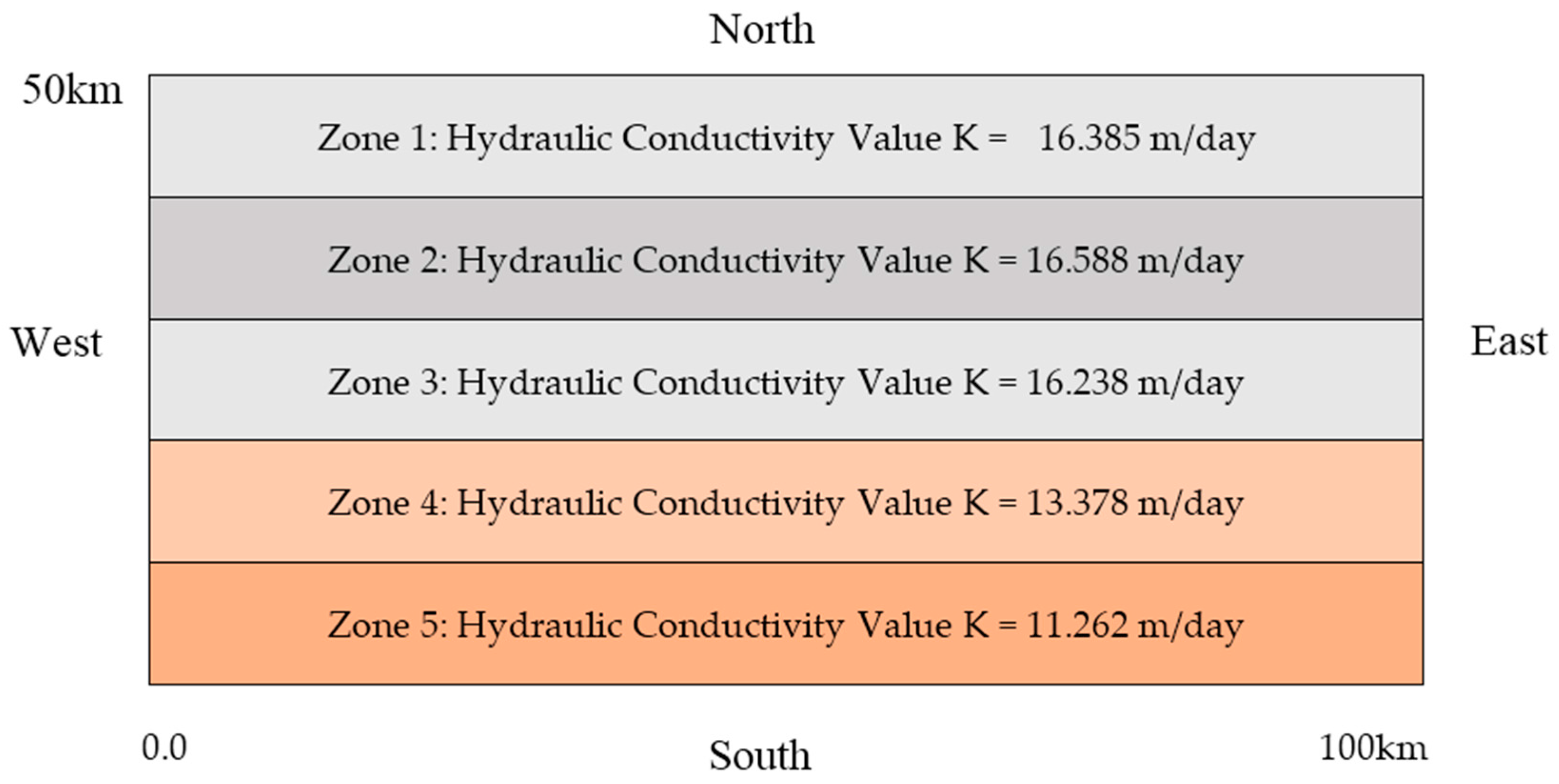
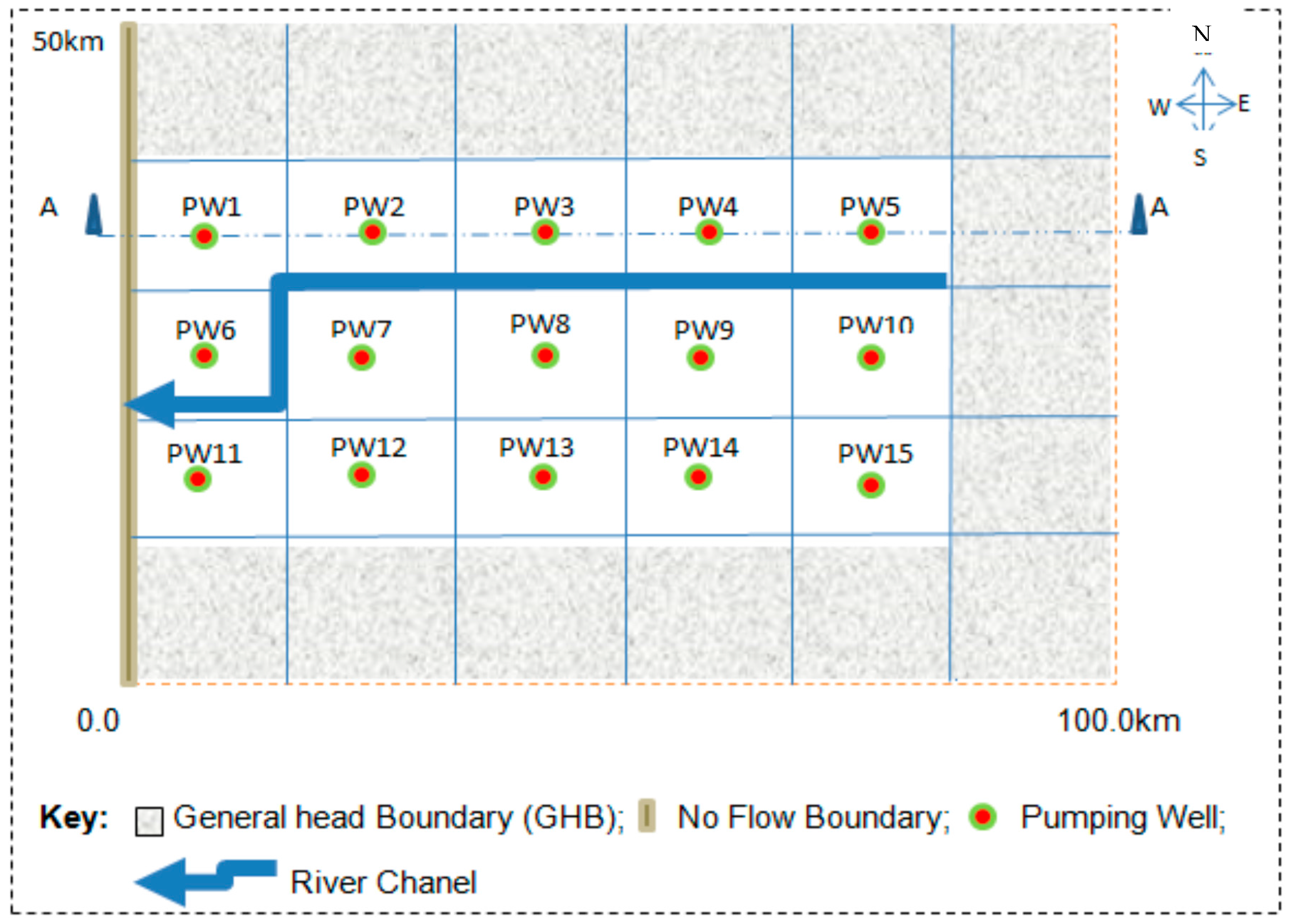
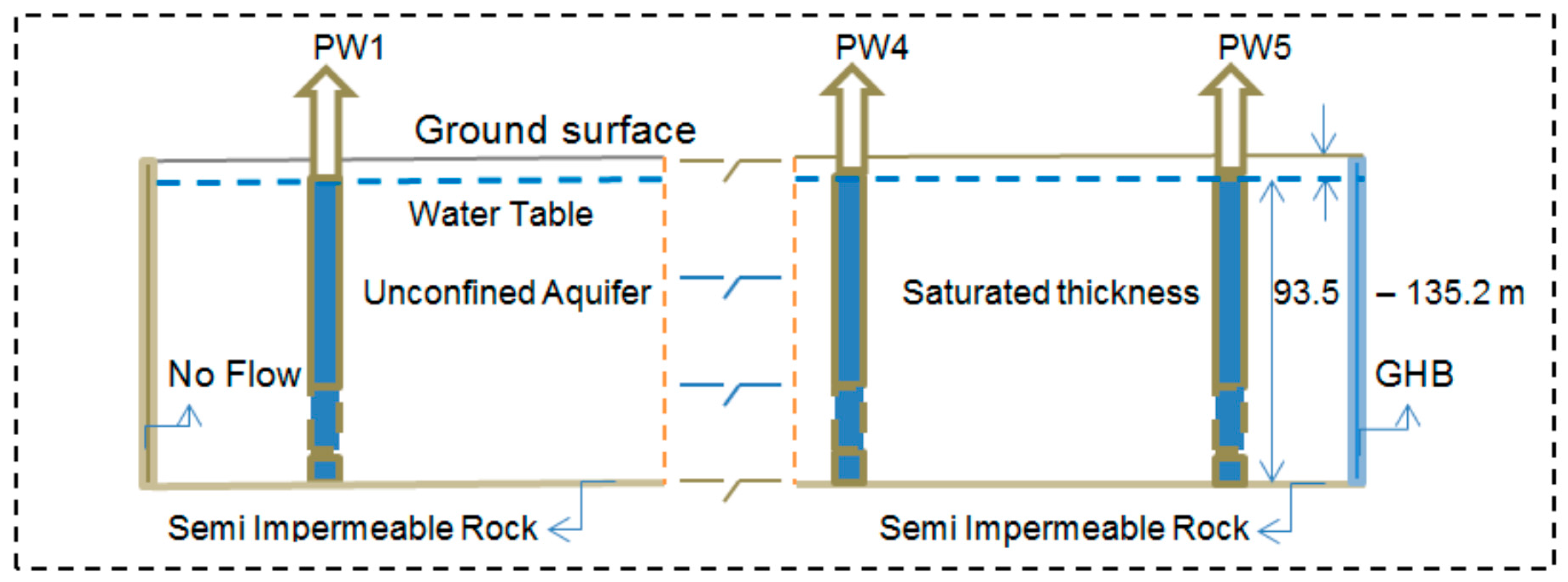
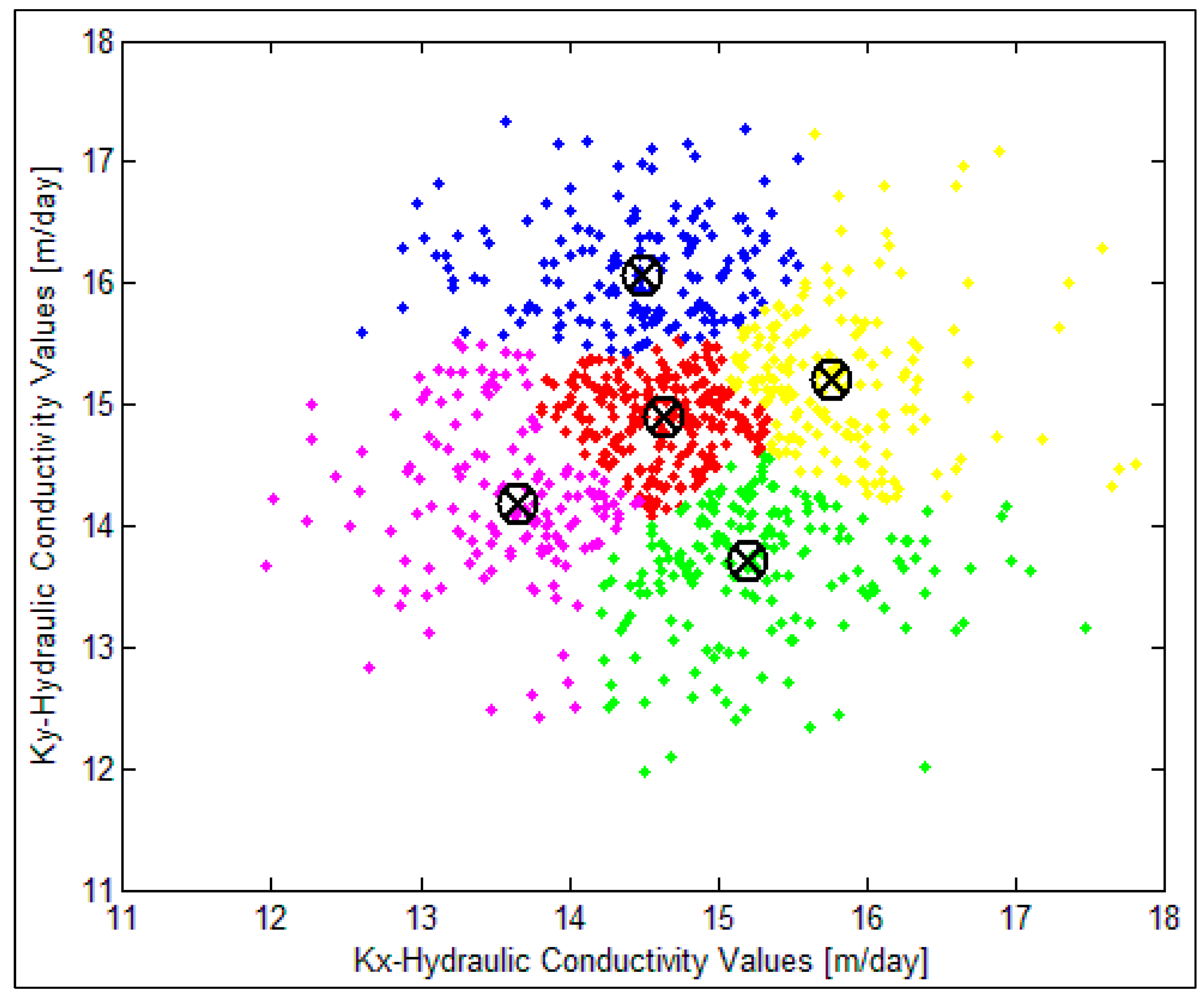
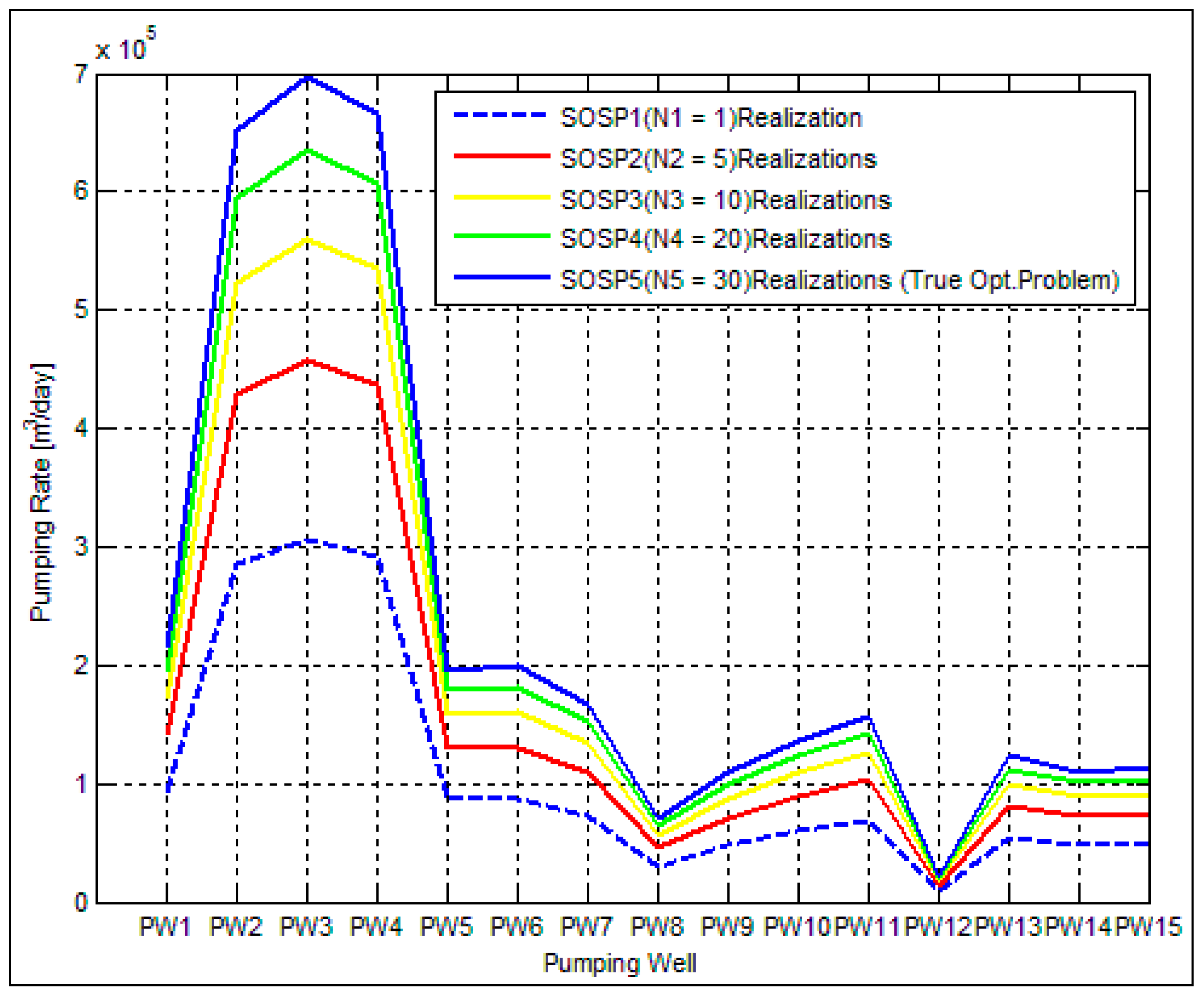
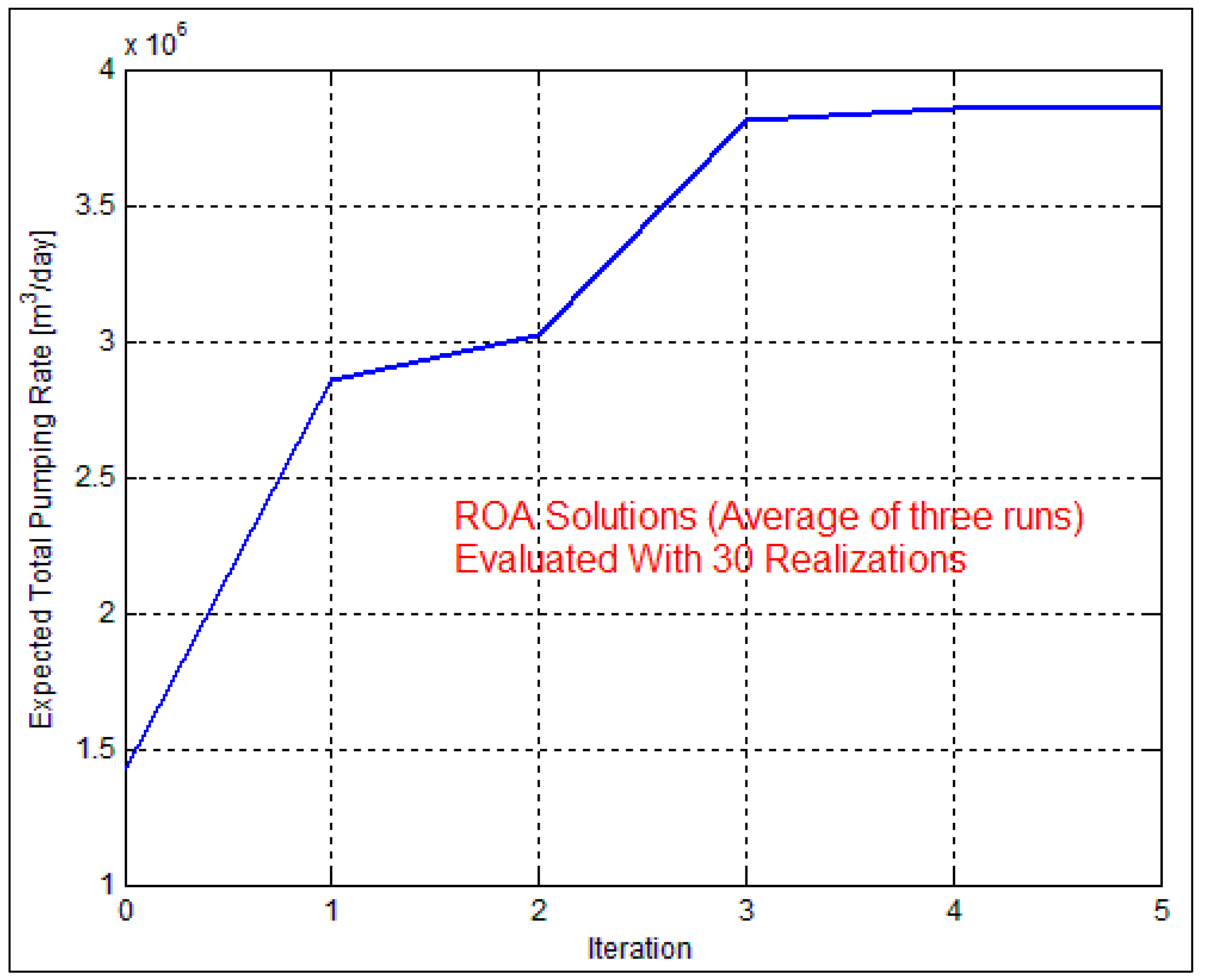
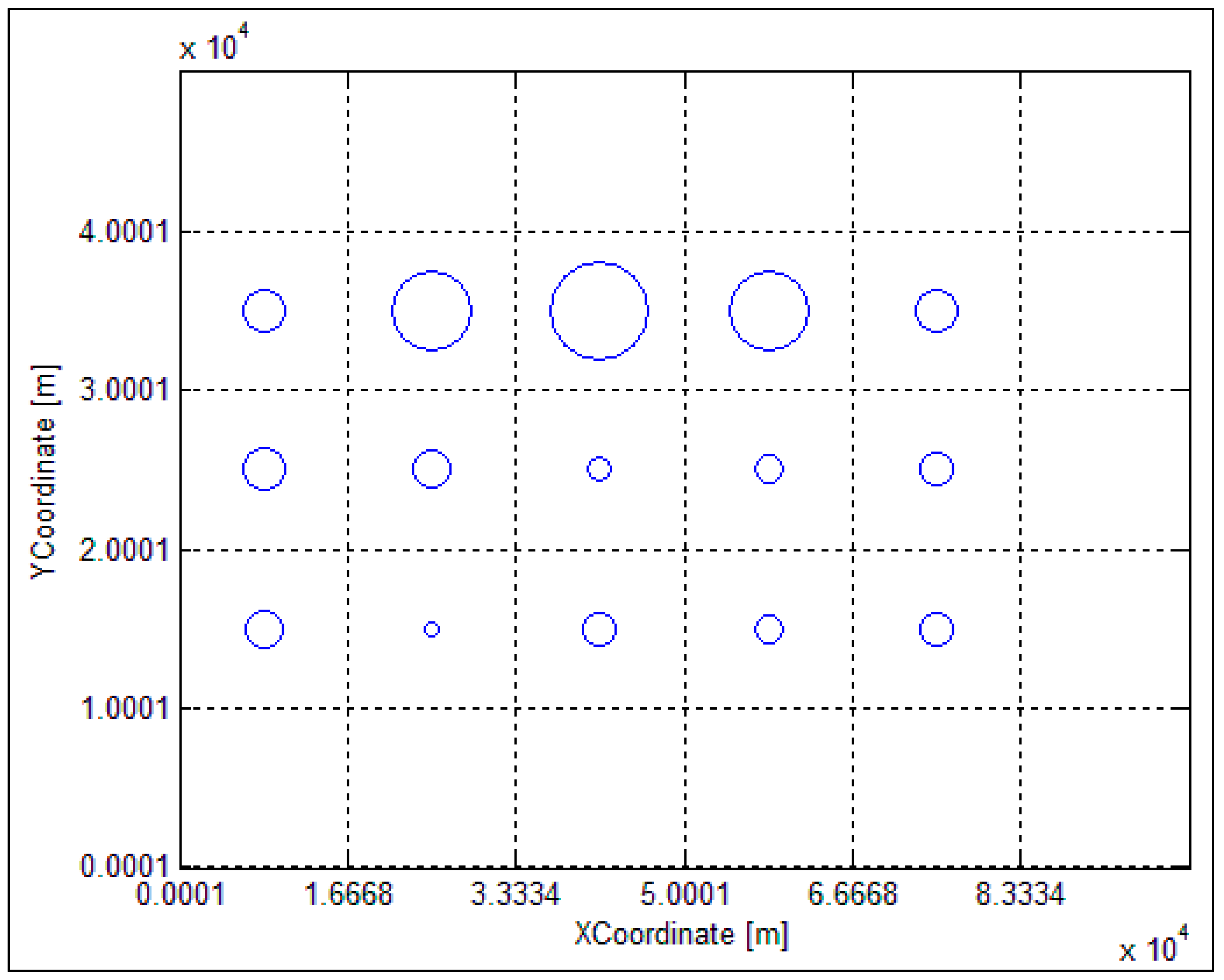
| Item | River/Aquifer System Property | Parameter Value |
|---|---|---|
| 1 | Mean Riverbed Hydraulic Conductivity | 0.2 m/day |
| 2 | Mean River Width Ranges | 80 m–100 m |
| 3 | Mean Riverbed Thickness Ranges | 2 m–3 m |
| 4 | Mean Aquifer Saturated Thickness Ranges | 93.50 m–135.20 m |
| 5 | Mean Aquifer Hydraulic Conductivity | 14.77 m/day |
| 6 | Mean Aquifer Specific Yield | 0.1 |
| 7 | Total Annual Aquifer Net Recharge | 106 mm/year |
| Sample path Sub-Problem | # of Realizations | Response Matrix (# of Rows/Constraints) | # of Columns (# of Decision Variables) |
|---|---|---|---|
| SOSP1 | 1 | 17 | 15 |
| SOSP2 | 5 | 85 | 15 |
| SOSP3 | 10 | 170 | 15 |
| SOSP4 | 20 | 340 | 15 |
| SOSP5 | 30 | 510 | 15 |
| Pumping Well | SOSP1 (N1 = 1) Optimal Pumping Rate (m3/d) | SOSP2 (N2 = 5) Optimal Pumping Rate (m3/d) | SOSP3 (N3 = 10) Optimal Pumping Rate (m3/d) | SOSP4 (N4 = 20) Optimal Pumping Rate (m3/d) | SOSP5 (N5 = 30) Optimal Pumping Rate (m3/d) | 50% * Saturated Aquifer Thickness (m) (Maximum Allowable Total Drawdown) |
|---|---|---|---|---|---|---|
| PW1 | 93,240.00 | 139,860.00 | 170,940.00 | 194,250.00 | 212,898.00 | 53.33 |
| PW2 | 285,480.00 | 428,220.00 | 523,380.00 | 594,750.00 | 651,846.00 | 54.27 |
| PW3 | 305,280.00 | 457,920.00 | 559,680.00 | 636,000.00 | 697,056.00 | 51.16 |
| PW4 | 291,600.00 | 437,400.00 | 534,600.00 | 607,500.00 | 665,820.00 | 46.78 |
| PW5 | 86,040.00 | 129,060.00 | 157,740.00 | 179,250.00 | 196,458.00 | 59.38 |
| PW6 | 87,120.00 | 130,680.00 | 159,720.00 | 181,500.00 | 198,924.00 | 56.09 |
| PW7 | 72,720.00 | 109,080.00 | 133,320.00 | 151,500.00 | 166,044.00 | 50.41 |
| PW8 | 30,600.00 | 45,900.00 | 56,100.00 | 63,750.00 | 69,870.00 | 47.06 |
| PW9 | 47,520.00 | 71,280.00 | 87,120.00 | 99,000.00 | 118,504.00 | 49.82 |
| PW10 | 59,400.00 | 89,100.00 | 108,900.00 | 123,750.00 | 135,630.00 | 54.93 |
| PW11 | 68,400.00 | 102,600.00 | 125,400.00 | 142,500.00 | 156,180.00 | 67.61 |
| PW12 | 9000.00 | 13,500.00 | 16,500.00 | 18,750.00 | 20,550.00 | 63.68 |
| PW13 | 54,000.00 | 81,000.00 | 99,000.00 | 112,500.00 | 123,300.00 | 56.45 |
| PW14 | 48,240.00 | 72,360.00 | 88,440.00 | 100,500.00 | 110,148.00 | 53.86 |
| PW15 | 50,040.00 | 75,060.00 | 91,740.00 | 104,250.00 | 114,258.00 | 59.10 |
| ∑ | 1,588,680.00 | 2,383,020.00 | 2,912,580.00 | 3,309,750.00 | 3,727,486.00 |
© 2016 by the authors; licensee MDPI, Basel, Switzerland. This article is an open access article distributed under the terms and conditions of the Creative Commons Attribution (CC-BY) license (http://creativecommons.org/licenses/by/4.0/).
Share and Cite
Kifanyi, G.E.; Ndambuki, J.M.; Odai, S.N. A Quantitative Groundwater Resource Management under Uncertainty Using a Retrospective Optimization Framework. Sustainability 2017, 9, 2. https://doi.org/10.3390/su9010002
Kifanyi GE, Ndambuki JM, Odai SN. A Quantitative Groundwater Resource Management under Uncertainty Using a Retrospective Optimization Framework. Sustainability. 2017; 9(1):2. https://doi.org/10.3390/su9010002
Chicago/Turabian StyleKifanyi, Gislar E., Julius M. Ndambuki, and Samuel N. Odai. 2017. "A Quantitative Groundwater Resource Management under Uncertainty Using a Retrospective Optimization Framework" Sustainability 9, no. 1: 2. https://doi.org/10.3390/su9010002





